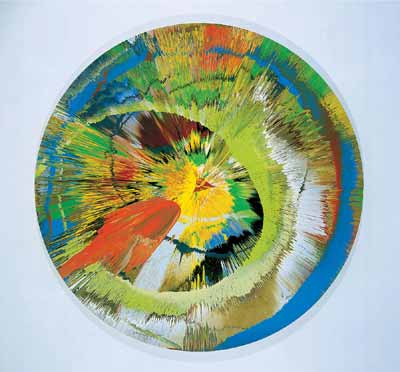In the modern-day world of prevailing dynamism, that is moving from progress to greater progress, or better said beauty to higher beauty in an endless motion, underneath all ostensible pandemonium and bewilderment. The trend, which dominates the globe, is its demonstration of orderliness and maintenance, which display their external mark and at the same time symbolize the inflexible geometry of the cities of the world. In its smoke trails, in its analogous car tracks, and its streets, its factories, and the bridges and its gas tanks, by making use of the underscoring mechanical configuration, the artist could generate a new appearance of optimism through the simple shapes in art forms. The artwork of Damien Hirst is deeply influenced by the modern world of complexities of culture that includes various parameters like social, political, technological, economic, and religious aspects.
Born in 1965, Damien Steven Hirst is considered one of the greatest living English artists and an active member of the YBA or “Young British Artists”. He came into prominence during the early part of the 1990s among the British artists and dominated the art scenario of the UK. Soon he was recognized as a prominent international artist at the beginning of the 2000s. He is almost overwhelmed by the concept of death. It can be stated that his artistic philosophy has been shaped and influenced by two different and opposing essences. One is beauty and the other is death. It is an interesting factor that these two elements are closely associated among the cultural aspects of the modern world and the artist has been highly influenced by these elements (Kar, p. 88).
These two elements gave rise to the elements of space and complexities of Hirst’s artwork. LSD by the artist represents a wide view of the influence of modern culture. The main aspect of this picture, from a viewer’s perspective, is to look for the philosophic approach that the painter has taken to enumerate the stability and inconsistency of life. This work of art is exquisite because it places the viewer’s perspective that can be termed as bilateral. It is down-to-earth and materialistic in one way and at the same time, it renders the spiritual aspects of existence. Not many art forms are capable of evoking such aura and thus it could be termed as work right out of the grade one hall of fame. Overall, to summarize, it can be specified that LSD presents the most powerful analysis of space and the complexity related to existence and the eternality prevailing with all the differences and barriers imposed. Thus, more widely the term ‘space’ can be used to depict a specific type of creative fabrication as engendering by human beings, and the term more often than not implies some extent of aesthetic value, which depicts the sensory or sensory-emotional values of the artist, and sometimes even portrays sentiments and tastes of that person. Thus, space in LSD can be well defined as a component of literature. Literature, no doubt, records in it the life and society from which it emerges, in doing so it can never distort the truth or magnify it. Thus like literature art is also a mirror of society (King, pp. 313-4).

Hirst started his life in a period of history that was a time when the world was going through a difficult phase after the horrors of the war juxtaposed with the influence of the beat generation. It could be mentioned in the initial stages that it was degeneration time. Imperialism had taken its tolls on the world, which was grilling on the last fires of the great wars. The losses were too heavy, and the shocks, almost unbearable. People just lived through a test of the extent-organized cruelty and purposeful ruthlessness could reach. As far as the future was concerned, the initial tremors of what would lead to a massive cross across the globe were being felt. In this context, it would be relevant to mention that the generation was not finding their existence worthwhile, or in other words, they wanted more out of their life for they hardly knew what to believe. They were not able to keep complete faith in religion and neither could they abandon it completely. The artistic influence of this time was confusing. They showed that the truth was no longer a romantic affair but it was more of a compulsion for which even lies would work well if that helps in survival (Lamb, pp. 227-9).
It was also a regeneration time. Ideological conflicts and military interests were shaking civilization right up to its foundations. The doubts, dilemmas, and confusions were gradually, quite slowly indeed, giving way to a new and unique cultural revolution. It was happening all across the Western world. People suddenly seemed to realize that there was enough political warfare to disgrace humanity. The prevailing standards suddenly seemed to be meaningless, and the insurgent youths wanted something different to happen.
From these parameters, the formulation of complexities is well defined in Hirst’s work LSD. Simultaneously, the aspects of death also influenced him along with the opening up of the world economy and the concept of the global village. Under this parameter, he understood the influence of an emerging monoculture and homogeneous nature of art philosophy that became more open and adjusting as ever. His work, 72″ diameter canvas Beautiful revolving sphincter, oops brown painting in 2003 pained with household gloss paint on canvas indicates this influence. It is referred to as ‘brown’ though it is a very colorful composition. This is where the concept of death comes into full being. The most important point to be noted in this respect is the amount of energy of space that is reflected within the parameter of this canvas (Sayre, p.177).
To ascertain a piece of canvas to be judged as a work of art it is necessary to evoke a certain feeling within the viewers. There is no grammar involved in this part; no mathematics is needed; only the artistic sense is operational in this context from the part of the viewer. The interpretation may vary but the theme that evoked the interpretation of the viewer is all that is important to certify a painting as Art. In this context, too, this painting comes out with excellence. He made space a meaningful narration and this makes this painting a brilliant work of art. His use of death as principal flourishes with the use of brown in the title. Thereby he indicates the artwork’s alignment with the death of colors and all beauty within (Fletcher, pp. 29-31).

In conclusion, it can be stated that nature is created by itself, while art is the creation of nature. Art knows no death, it is imperishable. As said by Longfellow that art is long and time is fleeting. The spices of nature are born only to die after a certain space of existence. Art continues indefinitely. Art alone enduring stays to us. The bust outlasts the throne, The coin, Tiberius. Art is never demonstrative; it never catches attention with an exhibitionistic appeal. A casual observer scarcely finds anything impressive, a thing of beauty, in it. On the other hand, the eye of a connoisseur never misses it. In the case of both the artworks, this maxim is established to its pinnacle.
Works cited
- Fletcher, R; Realism: Beliefs and Knowledge; Believing and Knowing. (Mangalore: Howard & Price. 2006)
- Kar, P; History of Realism (Kolkata: Dasgupta & Chatterjee 2005)
- King, H; Realism: Biographies (Dunedin: HBT & Brooks Ltd. 2005)
- Lamb, Davis; Cult to Culture: The Development of Civilization on the Strategic Strata. (Wellington: National Book Trust. 2004)
- Sayre, Henry, M; A World Of Art; Upper Saddle River NJ: Prentice Hall; 2006